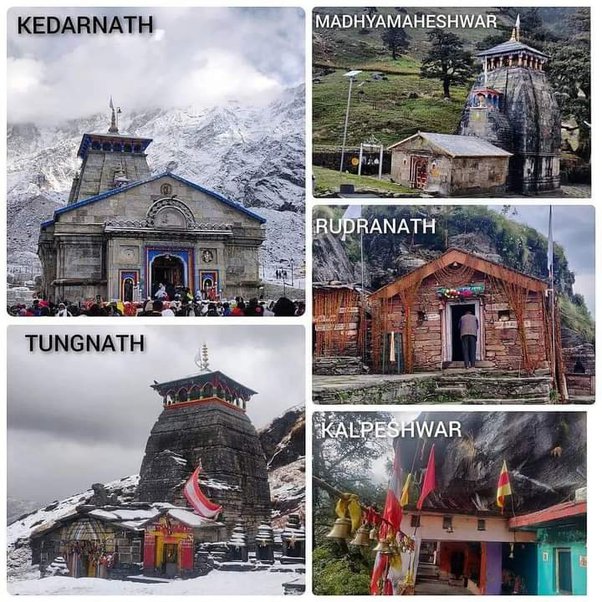
Uttarakhand is “heaven on earth”, surrounded with majestic mountains, in the lap of Himalayas, full of nature’s beauty, flowing rivers, variety of flora and fauna, pleasant weather, sacred temples, Char dham Yatra, Panch Kedar Yatra, Panch Badri Yatra and many more.
Uttarakhand is also known as “DEVBHOOMI” which means ‘Land of Gods’, history tell us all the connecting stories of ancient time, every place of Uttarakhand is related and dedicated to gods and goddesses. Mainly Uttarakhand is famous for Temples, where Devotees come in large number to worship god.
Although, Char dham, Panch Kedar, Panch Badri, Panch Paryag all are located in Uttrakhand state of India. Tourists in large number visit Uttarakhand every year.
Uttarakhand has been a place of worship and temples from ancient time. Lord Shiva is the most divine deity in Uttarakhand and one can find mostly temples dedicated to him only.
Most of Uttarakhand temples and shrines have connection with Lord Shiva in some form or other.
Among all the temples dedicated to Lord Shiva, the collection of five shrines of Lord shiva are the most appreciated. Famously known as Panch Kedar.
Panch Kedar is formed by parts of Lord Shiva’s body, that emerged at five places in Kedarnath town. It is believed that brother Pandvas built these temples at each of the five places. The Panch Kedar temple name are Kedarnath, Tungnath, Rudranath, Madhyamaheshwar, and Kalpeshwara.
Panch kedar yatra starts from Kedarnath temple and ends at Kalpeshwara temple, which takes around 14 days to complete the whole Panch Kedar Yatra.
Table of Contents
SHORT ITINERARY OF PANCH KEDAR
DAY1: DRIVE FROM HARIDWAR/RISHIKESH- SONPRAYAG/SITAPUR (STAY HOTEL)
DAY2: GAURIKUND TO KEDARNATH
DAY3: KEDARNATH TO GAURIKUND TO RANSI VILLAGE
DAY4: TREK TO NANU VIA GAUNDAR
DAY5: TREK TO MADHMAHESHWAR
DAY6: TREK DOWN TO RANSI VILLAGE- CHOPTA
DAY7: TUNGNATH- CHANDRASHILA- SAGAR VILLAGE
DAY8: TREK TO PANAR/ LWITI BUGYAL
DAY9: PANAR BUGYAL- RUDRANATH
DAY10: RUDRANATH- SAGAR VILLAGE- HAILANG
DAY11: KALPESHWAR- URGAM- JOSHIMATH/BADRINATH
DAY12: BADRINATH- RUDRAPRAYAG
KEDARNATH (1st IN PANCH KEDAR YATRA)
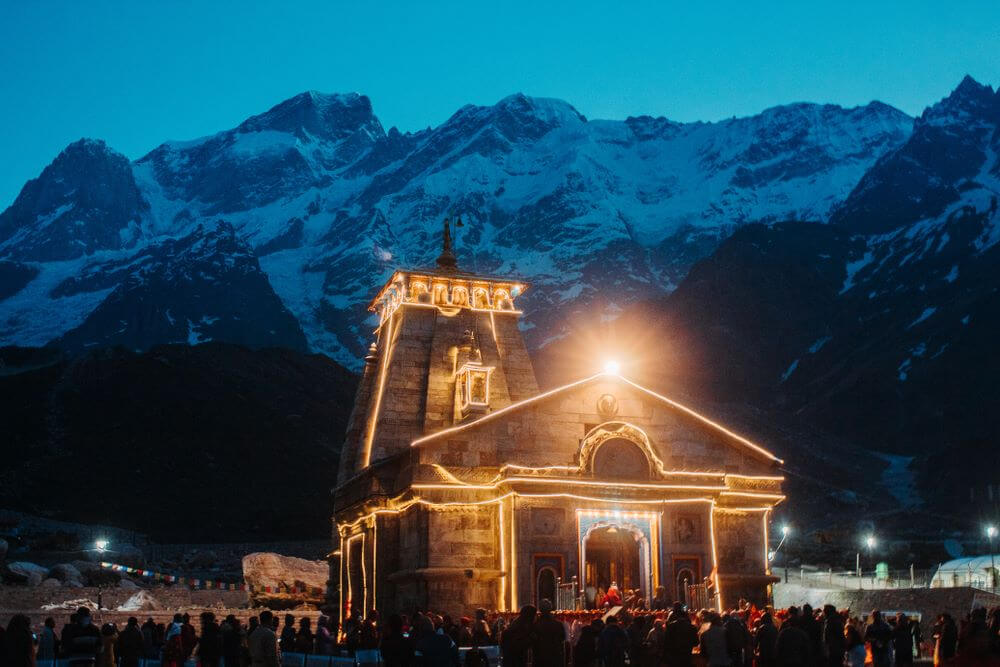
Kedarnath is a sacred Hindu temple and one of the Panch Kedar situated in the district of Rudraprayag in Uttarakhand state. It is also one of the Chard Dham’s situated in Northern Himalayas.
Kedarnath is located at a altitude of 3584 meters above sea level., and is near the beginning of the Mandakini River. The temple Kedarnath lies in the lap of majestic Himalayas, and thousands of tourists and devotees visit Kedarnath each year.
HISTORY OF KEDARNATH
According to famous Hindu Mythology related to the history of the origin of Kedarnath temple, is that after war of Mahabharat , the pandavas went on an mysterious journey to beg mercy from Lord Shiva. After failing attempts, Bhima was able to find Lord Shiva, who embodied as a bull to hide from Pandvas.
Bhima attempted to catch it and hit its hidden parts with his baton. The harmed bull then submerged in the earth and its body parts appeared in different places. It is trusted that the hidden part of the bull appeared at Kedarnath, from which a ‘jyotirlinga’ or light or flame flickered and lord shiva appeared in his real Avatar.
After taking blessings from Lord Shiva, the Pandvas were spared of their sins and Lord Shiva told them “from now onwards, I will be present here in the form of triangular shaped Jyotir Linga”, and by paying worship at Kedarnath, the devotees will attain devotion. From then the triangular Lingam is worship at the “Garbhgirah” of the Kedarnath Temple.
MADAMAHESHWAR (2ND IN PANCH KEDAR YATRA)
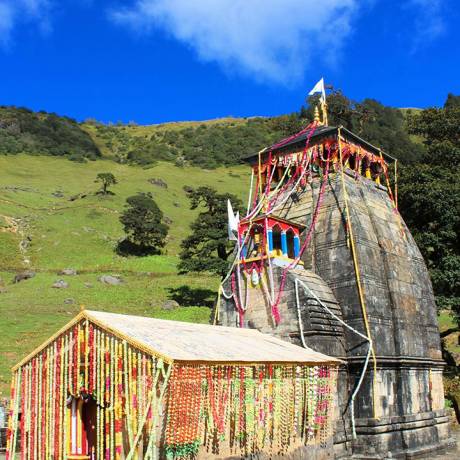
Madhmaheshwar temple is mesmerizingly covered by snow-topped Himalayas on the right side, lush green grasslands on the left side and dense forest at the back.
Madhmaheshwar also known as MadhyaMaheshwar is alittle sacred town named after the temple of Lord Shiva. It is situated at an altitude of 3490 mts above sea level.
This temple is dedicated to Lord Shiva, which is part of the Panch Kedars. This is the second temple visited in the Panch kedar Yatra. The middle part (Madhya) or navel of the bull, in the form of Lord Shiva, is worshiped here by Devotees. Bhima one of the Pandva brother is believed to have built this shrine, and used to worship Lord Shiva here.
HISTORY OF MADHMAHESHWAR
Madhmaheshwar is the second temple among the Panch Kedars, after killing their cousins in the war Pandavas started their journey to search Lord Shiva, in order to wash their sins. As Lord Shiva wanted to avoid them, as he was very angry at the death and dishonesty at the Kurukshetra war.
Therefore, he converted himself in the form of bull (nandi) and disappeared with different parts of body appearing at various places. Here in Madhmaheshwar Lord Shiva is worshiped in the Navel-shaped Lingam.
TUNGNATH (3RD IN PANCH KEDAR YATRA)
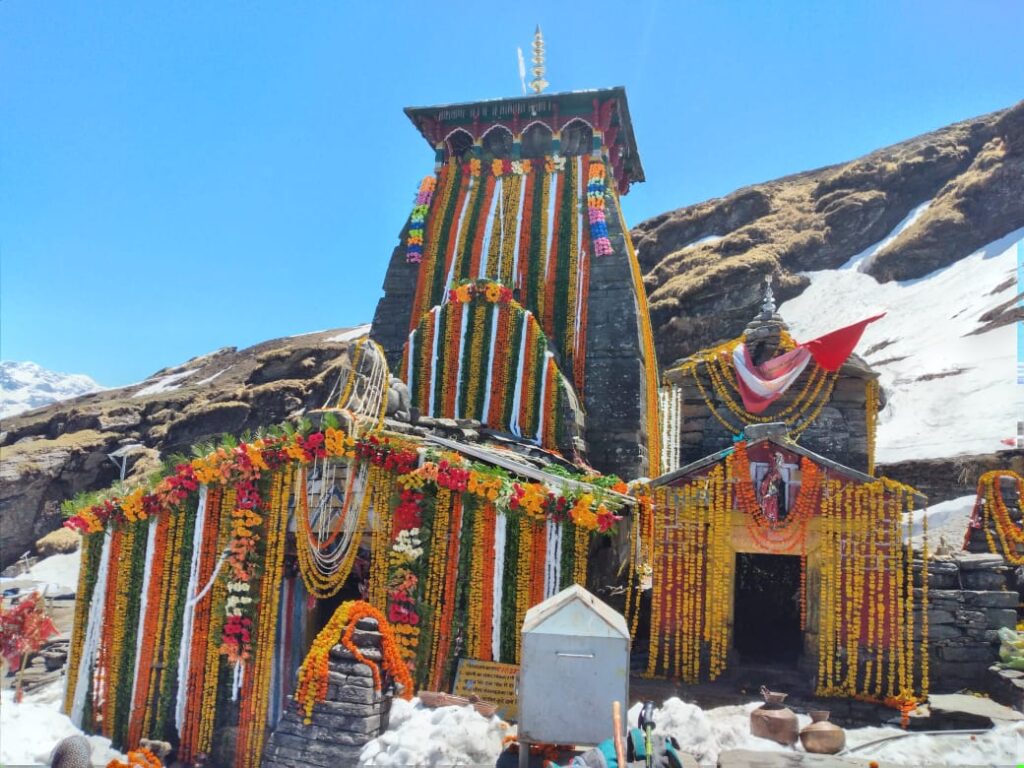
Tungnath located on the Chandranath Parvat is the highest Lord Shiva temple in the world. And highest among all the Panch Kedars. It is the third in visiting during Panch Kedar Yatra. Tungnath is situated at an altitude of 3,80 meters above sea level and is believed to be more than 1000 years old.
Amazing in architecture and structure, Tungnath is observed to be more than 1000 year old, which is dedicated to Lord Shiva, goddess Parvati, and few other gods can be seen in temple. This temple was detected by Adi Shankracharya and the priest of this temple currently are Brahmins of Makku village.
The divine image of Lord Shiva is moved to Mukunath during winters (snowfall), situated 19 kms away from tungnath. The trek to the temple goes from meadows, lush greenery, and Rhododendron bushes offerings the beautiful view of nature.
HISTORY OF TUNGNATH
The history of Tungnath is connected with the epic Mahabharta. When Pandavas wanted to wash their Sins, they started searching Lord Shiva, as Vyas Rishi told them that only worshipping Lord Shiva will forgive and wash their sins off. They kept searching for Lord shiva in the Himalayas because they were guilty of killing their cousin brothers.
Lord Shiva wanted to escape from Pandavas, that’s why Lord Shiva converted himself in a form of bull and took safety underground. The places where part of bull (Lord Shiva) were found are all known as Shiva’s temple.
In Tungnath his (bull) hands (bahu) were supposedly seen. From then this temple is worshiped by devotees.
RUDRANATH (4THIN PANCH KEDAR YATRA)
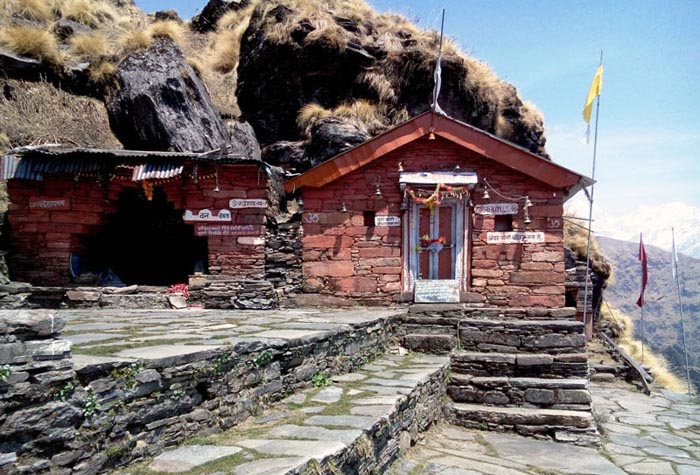
Rudranath is Lord Shiva temple peacefully embellished in the Garhwal Himalayas. It is the fourth temple in the sequence of Panch Kedar Pilgrimage.
The heavenly temple is nestled in between the Rhododendron forests and the alpine grass lands. The exciting trek to Rudranath temple can be either started from Sagar village, Helang or Urgam village.
Rudranath shrine is toughest among all Panch Kedars to reach. Himalayan peaks add beauty to the temple of Rudranath.
HISTORY OF RUDRANATH
Rudranath temple is fourth among the Panch Kedar Pilgrimage shrines. After the war of Mahabharata Pandavas went in search of Lord Shiva to wash their sins, Lord Shiva was angry and wanted to avoid them, therefore he converted himself in the form of bull (Nandi) and faded in the ground.
The brother Pandavas built all the temples where his body parts were supposedly resurfaced and worshiped him to please him, and for getting rid of their sins. That is how Rudhranath temple was discovered and built.
In Rudranath Face of Lord Shiva is mysteriously represented on a Lingam, and is worshiped in the temple of Rudranath.
KALPESHWAR (5TH IN PANCH KEDAR YATRA)
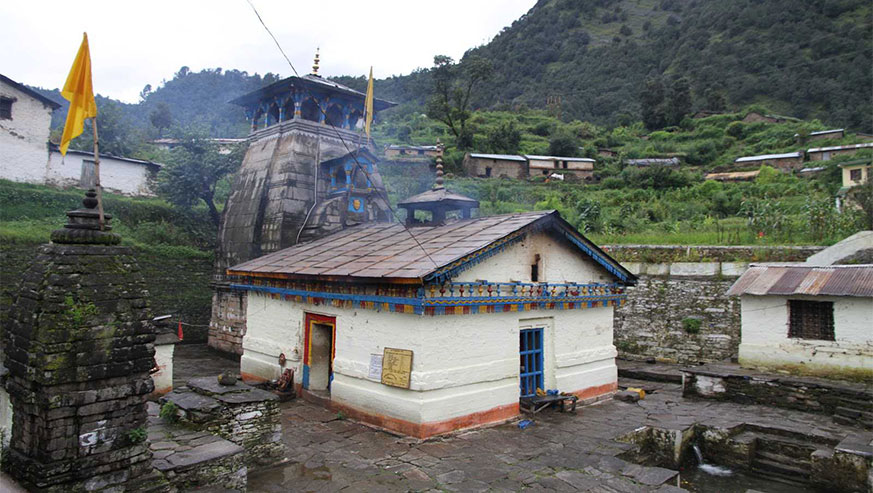
Kalpeshwar is the last one visited at last among Panch Kedar Pilgrimage, and also it is the one which is open throughout the year among all five shrines of Panch Kedar.
In Kalpeshwar Lord Shiva is worshipped in the form of matted hair, and the stretch goes through dense forest and lush green fields of grass. There is also an old Kalpvriksh tree which is believed to be the wish-completing tree in Hindu Mythology.
It is an ideal spot for trekking enthusiasts which starts from Urgam village. You will find apple gardens and potato field walking this trek.
HISTORY ABOUT KALPESHWAR
There are several sayings and belief related to Kalpeshwar temple, but mostly told is that after the war of Kurukshetra Pandavas went on a mysterious journey to beg forgiveness from Lord Shiva.
They searched for Lord Shiva but were unable to find him, Bhima one of the Pandava brother was able to recognize Lord Shiva who took the avatar of Bull.
When bhima vigorously tried to hold the bull by its tail and hidden legs, it submerged on the ground. Later, his body parts appeared in several places. It is believed that ‘Jata’ the locks of Lord Shiva supposedly appeared at Kalpeshwar.
ITINERARY OF PANCH KEDAR
DAY1: DRIVE FROM HARIDWAR/RISHIKESH- SONPRAYAG/SITAPUR (STAY HOTEL):
Drive from Haridwar/Rishikesh to Sonprayag or Sitapur (depends on accommodation booked/available).
DAY2: GAURIKUND TO KEDARNATH:
TREK 24 KM
Drive to Gaurikund, trek 24 km. You can also take helicopter to cover the distance. Keep one reserved day as directly getting down the next day will make you tired at the very beginning of the Panch Kedar.
DAY3: KEDARNATH TO GAURIKUND TO RANSI VILLAGE:
TREK 24 KM
After breakfast, trek back to Gaurikund. After reaching Gaurikund take some rest and then start your journey again and drive to Ransi Village. After reaching Ransi village we will have dinner, after that you can rest in the hotel of ransi village. Ransi village is the starting point of Madmaheswari trek. Overnight stay will be at Ransi village.
DAY4: TREK TO NANU VIA GAUNDAR:
Ransi village is the starting point of MadHmaheshwar trek. So you have to wake up early in the morning and do breakfast on time. You have to trek for Nanu via Gaundar. The beauty of this area while trekking will make your experience memorable.
After reaching Gaundar you will have dinner and rest at your tents/ homestay overnight at Nanu.
DAY5: TREK TO MADHMAHESHWAR:
In morning after breakfast, your trek to Madhmaheshwar starts. You will have dinner and overnight stay at Madhmaheshwar.
DAY6: TREK DOWN TO RANSI VILLAGE- CHOPTA:
On next morning after breakfast, you will have to trek down to ransi village (18kms) and after reaching Ransi Village you have to drive to Dugalbitta, Chopta.
Dinner and overnight stay will be at hotel in Chopta.
DAY7: TUNGNATH- CHANDRASHILA- SAGAR VILLAGE:
After breakfast in the morning your trek will start to Tungnath and beyond Chandrashilla. After reaching the temple you will take blessings from God and trek back to Chopta and drive to Sagar Village.
Dinner and night stay will be at hotel in Sagar.
DAY8: TREK TO PANAR/ LWITI BUGYAL:
In the morning after breakfast your trek will start from Sagar to Panar/ Lwiti Bugyal which is almost 12 km.
Dinner and overnight stay will be at Panar/ Lwiti Bugyal hotel.
DAY9: PANAR BUGYAL- RUDRANATH:
After breakfast in the morning you have to trek to Rudranath Temple. After reaching the sacred shrine take some blessings from God enjoy the surroundings and environment of the temple and get back to Panar Bugyal.
Dinner and night stay will be at hotel in Panar/ Lwiti Bugyal.
DAY10: RUDRANATH- SAGAR VILLAGE- HAILANG:
In morning, after breakfast, you have to trek down to Sagar Village and start your drive to Hailang.
Dinner and stay of night will be at Hailang hotel.
DAY11: KALPESHWAR- URGAM- JOSHIMATH/BADRINATH:
After breakfast in the morning your trek starts to Kalpeshwar temple which is almost 12 km, after taking some blessings we will return back to Hailang.
Drive to Joshimath/ Badrinath, night stay will be at the hotel in Badrinath.
DAY12: BADRINATH- RUDRAPRAYAG:
Early morning darshan at Badrinath temple and back to hotel after breakfast. Drive from Badrinath to Nandaprayag then Karnaprayag and further to Rudraprayag and Devprayag and then to Haridwar/ Rishikesh.
Note: Keep 1 extra day just in case of bad weather or bad health.
INCLUSIONS
- ACCOMMOODATION: accommodation on a triple sharing basis, in hotel, homestay,etc
- TRANSPORTATION: Drive by Sumo/ bolero/ tempo traveler ( depends on the number of travelers).
- MEALS: All vegetarian meals from day 1st dinner to day last day breakfast.
- SNACKS: Morning/Evening tea/coffee with light snacks and soup while on the trek.
- CAMPING LOGISTICS: Tent, sleeping bags, mattresses, dining tent, toilet tent.
- TREK LEADER: Qualified and experienced trek leader and support staff.
- PERMITS: All necessary fees and permits.
- TREKKING EQUIPMENT: Gaiters, micro spikes, and rope if required.
- Safety Equipments: Basic first aid kit with oximeter and oxygen cylinder.
- GUIDE RATIO: 1:10
EXCLUSIONS
- Any expenses of personal nature.
- Meals during transit.
- Insurance of any kind.
- Any fees and permits (for non-indians)
- Unscheduled delay due to a landslide.
- Cost Escalation due to “force majeure and evacuation charges”
- Anything not mentioned explicitly in the above program.
CANCELLATION POLICY
- No Cancellation will be taken over phone calls or WhatsApp messages. Please reply to the email of the payment receipt that you received at the time of booking regarding the cancellation.
- Free Cancellation up to 45 days before the departure date. (booking amount is non-refundable)
- 44 Days to 30 days of departure date. 10% of the total trip cost along with the booking amount will be charged as a cancellation fee.
- 29 Days to 20 Days of departure date. 25% of the total trip cost along with the booking amount will be charged as a cancellation fee.
- 19 Days to 10 Days of departure date. 50% of the total trip cost along with the booking amount will be charged as a cancellation fee.
- 10 Days to 6 days of departure date. 75% of the total trip cost will be charged as a cancellation fee.
- 6 Days to trip departure date. 100% of the total trip cost will be charged as a cancellation fee.
- NO SHOW. NO REFUND.
- Note: All the reimbursements/ refunds will incur a Payment Gateway charge of 2.5% & GST at 5% respectively. The payment Gateway charges will not be levied to the customers who have made their transactions via UPI.
- Please also note that the booking amount for all packages/ trips is non-refundable whereas a Credit Note can be issued if the cancellation is made 3 days before the departure date (at the discretion of the organization)
- In case of government orders, harsh weather conditions, protests, landslides, or any other unforeseen circumstances, we work out the best possible alternate plans or trips/ treks. At times even if certain activities are canceled, the organization provides the best alternative but no refunds are provided.
- If a trek/trip cannot be completed due to natural calamity or unfortunate circumstances (like rain, snowfall, earthquake, landslides, strike, bandh, etc.). No refund would be provided.
- Any extra expenses coming due to any natural calamity mentioned above, will be borne by customer. The company will not be liable.
- Cancellation policy will differ the peak season and for popular places.
THINGS TO CARRY
- RUCKSACK (Min 55 liters with rain cover): You must carry a good quality of backpack with a comfortable fit and fluffy straps that will not hurt or pain in your shoulders.
- GLOVES: Insulated gloves helps your body and hands to keep warm. And it also provide good grip during trekkers.
- SUN CAP: A sun cap with side flaps and light weight is perfect to avoid you from sunburn and direct heat.
- 1 SCARF OR BALACLAVA: Along with sun rays you get hit by dirt and germs during trek which is why it’s important to carry a scarf or balaclava to cover your face when needed.
- LIP BALM: Lips can become dry, chapped, due to the cold weather during climbing, its important to keep them properly moisturizer.
- COLD CREAM/ MOSTURIZER/SUNSCREEN(SPF40): To avoid sun burns and tanning, you need to put on sunscreen, and for making skin moisturized you need to put cold cream or moisturizer to keep it safe from dryness or roughness.
- ANTIBACTERIAL POWDER: To avoid rashes from uncertain bacteria in you arm pits or other parts of the body.
- WATER BOTTLE 1 LITER: Hydrating your body is most important, when it comes to trekking, so keep a water bottle of at least 1 liter, which you can re-fill in the water springs of the mountains during trekking.
- FLOATERS OR SANDALS: Trekking requires a good quality of shoes, you still need to let your feet breathe to avoid chafing and blisters of feet, so when you camp at a stop during trekking carry good pair of sandals or floaters to move your feet freely.
- TREKKING SHOES: Shoes for trekking must be good, comfortable, must provide ankle support, and also must have good grip. Shoes must be light weight but strong for trekking.
- EXTRA CLOTHES: Carry extra clothes and quick drying clothes with yourself, as the trek will be of long distance, you need to be prepared before for everything.
- TREKKING POLE: Trekking pole is important to provide stability and proper balance while walking and it saves energy also.
- DOCUMENTS: Identification proof like aadhar card, driving license, voter card, etc
- EXTRA POLYTHENE: In case your clothes get wet or dirty, and don’t get dry, you can carry them by packing in the polythene. Only, take care that the plastic you’re carrying must leave with you, don’t litter in the mountains.
- CAMERA: This should be important. To capture every memorable moment and every trek you visit, it’s important to capture all the moments in the camera, to remind them through pictures and to live the experience through them. Also bring extra batteries and storage.
